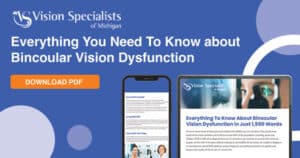How your agoraphobia or anxiety could be caused by a vision misalignment
Imagine this: you walk into one of those supercenter stores where they sell everything from groceries to car parts to gardening supplies. It’s a huge store and it’s brightly lit with fluorescent lights that hurt your eyes. The aisles are filled with products in all kinds of shapes and colors, and it almost feels a bit cramped. Now add people—lots of people—and the accompanying sounds they make: talking, pushing carts, crying children, cell phone conversations, announcements from overhead, employees’ walkie-talkies beeping and crackling. You’re just trying to find a few things but even the shortest errand feels exhausting. Does that sound familiar--and uncomfortably overwhelming?For many, it is. These circumstances can cause anxiety, which in turn can lead a person to avoid going to that store or any similar trips because of the fear of triggering that anxiety (agoraphobia). Just the thought of these errands can cause a person to become anxious after one bad incident. For some of these people, it’s a new development that seemingly came from nowhere; for others, the anxiety stems from a traumatic brain injury, post concussive syndrome, or other injury as one more relentless symptom to deal with on a daily basis.What most of both of these groups of afflicted people don’t know is that it could be a result of a vision misalignment not found in routine eye exams.When our eyes “see,” our brain processes and relates what we’re seeing, translating the images our eyes pick up and making sense of them. But if a misalignment occurs, the brain isn’t sure how to process the incoming images, which can be quite the headache—literally. Other symptoms include anxiety, head or neck aches, lack of balance or coordination, bouts of dizziness, difficulty with near or far tasks or reading. The feeling of being closed in or off balance will frequently accompany a vision misalignment. The anxiety can come about from a brain injury (the blow to the head may have knocked eye muscles out of alignment) or can occur without an injury (eye muscles may have been over-correcting for years and one day, the muscles finally give out, and the result is a misalignment).This is what Sarah Johnson* experienced for years. The symptoms began during her pregnancy—a spinning sensation and frequent headaches. They grew progressively worse over the years, made worse by computer work and driving. When Sarah got behind the wheel of her car, the anxiety would kick in within minutes. Traffic lights would blur together, making the anxiety so bad, she often had to pull over and call a family member to pick her up. When she would walk through department stores she had previously loved to shop in, she found herself growing anxious and stressed, so much so that she stopped going.It was years of this kind of misery until someone referred Sarah to Vision Specialists of Michigan. She visited the website before making her appointment and as she read through other patients’ stories, she thought to herself “they sound just like me!” At her first appointment, she received a pair of aligning glasses to try on. “To my surprise,” Sarah said, “all of my neck and back tension released. Everything looked clearer to me and it was amazing.” While it took a few appointments to adjust her aligning glasses, Sarah was thrilled to be driving without anxiety a few months later.In early 2016, the Vision Specialists Institute, a research NeuroVisual specialty practice, published findings in the Brain Journal relating to the treatment of anxiety through aligning glasses. Researchers noted that approximately 5–10% of patients with traumatic brain injury (TBI) develop persistent post-concussive symptoms, many of whom received little to no resolution for their symptoms. They took 38 patients with persistent post-concussive symptoms of headaches, dizziness, and anxiety who were diagnosed with a vision misalignment (the technical term is vertical heterophoria) and fitted them for special realigning glasses. The result? An overall improvement of symptoms (anxiety, dizziness, headache) by 80%, a drastic improvement in the patients' quality of life.If Sarah’s story sounds familiar, please share it with your friends and family. You never know who may be struggling with an unresolved symptom—this could be a key piece of their puzzle! If you would like to take a screening questionnaire to find out if you have a vision misalignment, visit IsItMyEyes.com.*Name changed to protect privacyFiled Under:
Tagged With: Agoraphobia, Anxiety, anxiety and vision, subtle vision misalignment,







